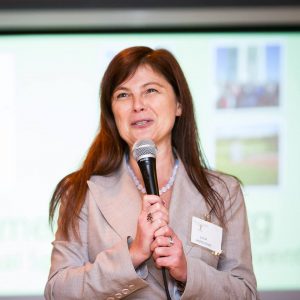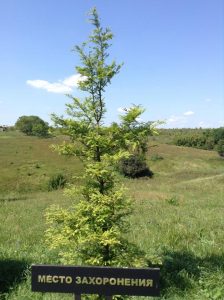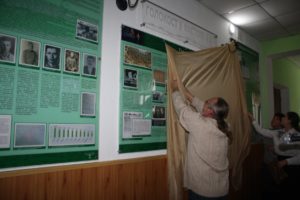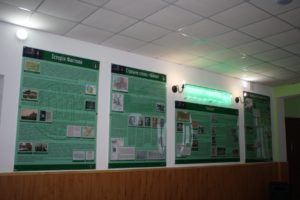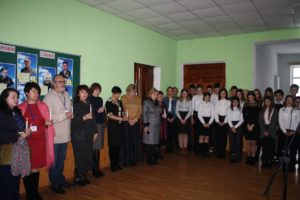
In this edition of Ukrainian Jewish Heritage, we’ll be speaking again with Julia Korsunsky, the executive director of RememberUs.org, a nonprofit organization based in Massachusetts.
We were first introduced to RememberUs.org when we learned about their project of planting metasequoia trees at mass grave sites of Holocaust victims. These include her own great-grandparents and many other relatives.
By their very nature, these trees are appropriately symbolic for this purpose. They’re resilient, able to adjust to different climates, enduring, strong and perdurable, just like the Jewish people. Thought to be extinct, the metasequoia was discovered in fossils in the 1940s. Today, metasequoia trees can be found in botanical gardens and parks around the world as well at a growing number of Holocaust killing sites. The trees have been planted at several sites in Ukraine and the project continues.
However, it is just part of a larger endeavor. As Julia explained in our interview, which aired in June of 2018. In mid December, she shared some exciting news about the second phase of the project, the opening of a new museum.
Pawlina: So Julia, you’ve been hard at work there at Remember Us, since we last talked. And this is something that you do in your spare time. It just amazes me what you do. Now, you messaged me just a few days ago and I’m really honored that you shared your news with me … and your excitement! So thank you very much for that. And now you’ve got me very, very curious! So let’s start at the beginning. You said just now that this is actually step two or phase two of what RememberUs.org is all about. And you started out with metasequoia trees.
Julia Korsunsky: Right. So we have developed kind of a comprehensive program that we call The Last Mile. And that program consists of four steps. And step number one would be to raise awareness about what happened in that particular area, in that particular city or town or village. And bring kids, and they often bring authorities to the place of the killings of this horrible event and tell people about what happened there. And we’ll plant metasequoia. And that’s what we talked about the last time when we talked. The next step would be to … we select a school—actually sometimes a school selects us—and we open a museum/permanent exhibition in the school about the local Holocaust, about local Shoah events that happened in that particular area.
Julia Korsunsky: And that’s what we did a very recently in Fastiv. And I did message you because I was very excited when we finally opened that exhibition. This is not the first time we did that. We have a function in museums, in other schools, in other towns and other cities. I can talk about that, but this one was especially exciting because it was the hardest project we have done and we’ve done many projects in the five years of our existence. We just by the way celebrated our 5th anniversary.
Pawlina: Oh, well congratulations!
Julia Korsunsky: Thank you. Thank you, yeah. And this was the hardest project, so I was very excited that this exhibition opened.
Pawlina: So where exactly is Fastiv?
Julia Korsunsky: Fastiv is a relatively small city in the Kyiv region. It’s about probably 30 or 40 minutes from Kyiv driving. It’s in the Kyiv area. In fact, during the war there was one of the largest battles that happened in Fastiv. And of course the reason I know [is] because I was collecting all those materials. So I have learned myself a lot about the history of that region, which is very interesting. And the history goes back to 13th or 14th century.
Pawlina: Oh wow.
Julia Korsunsky: Yeah.
Pawlina: So why in particular, what was it … some specific event during World War II during the Holocaust that this particular location was selected? I guess first of all, I should clarify, is it a new museum or is it an exhibit at an existing museum?
Julia Korsunsky: Oh, this is absolutely a new museum. So when we talk of “museum,” it’s important to understand—when we think we, Americans, Canadians, think about a museum, we think about a large building with many rooms and multiple exhibitions. When we talk about the museum that we are creating… that’s not what we do. That’s why I keep saying museum exhibition. For example, in Lubny, that’s another place where we opened, it’s actually in an associate village, which is next to a larger town, that’s called Lubny. It’s in Poltava region. And there we opened a room, an exhibition room, and later the school principal turned it as a stage one of a five-room museum.
Julia Korsunsky: So the first room is our room of Holocaust. And then he made one for Holodomor and other different aspects of that area. It’s actually a very interesting museum. In fact, it’s a little bit different. At this point they don’t have a designated room for the museum, so it’s in a large hall where we put our exhibition. And we actually put a TV there so they can show documentaries with the students as well. And it is from scratch. What’s interesting and difficult about the Fastiv museum was that we did all stages of museums ourselves. Our team on this side and on the other side, we collected materials, we designed how the exhibition is going to look, we designed the posters and of course we made them and installed the posters and the other things.
Julia Korsunsky: So the first room is our room of Holocaust. And then he made one for Holodomor and other different aspects of that area. It’s actually a very interesting museum. In fact, it’s a little bit different. At this point they don’t have a designated room for the museum, so it’s in a large hall where we put our exhibition. And we actually put a TV there so they can show documentaries with the students as well. And it is from scratch. What’s interesting and difficult about the Fastiv museum was that we did all stages of museums ourselves. Our team on this side and on the other side, we collected materials, we designed how the exhibition is going to look, we designed the posters and of course we made them and installed the posters and the other things.
Pawlina: I can see the excitement in your face here …and hear it in your voice. So how then is this different? And you said this is the most difficult, I mean you gave us kind of a list of the things that you did. But did you have fewer people to help with or …what was it that made it so much more difficult this time? And obviously it is much more of an accomplishment because you overcame those difficulties.
Julia Korsunsky: So it was the most difficult because of the level of our engagement. In other museums in Kremenchuk and Zozulia, we had a different level of partnership and different level of engagement of a local school or Jewish community or non Jewish community than we had in Fastiv. And in Fastiv—everything was done by our team. And when I say “our team” I don’t mean only people here in the United States, but also people in Ukraine. And we collected materials. We started doing research and we collected materials from everywhere. We contacted the U.S Holocaust Museum. We collected materials from multiple Ukrainian archives. We found materials in an Australian library. I mean literally, literally we went far and beyond.
Pawlina: Wow. How long did this take you?
Julia Korsunsky: I think we started just before our shtetl trips, when were just getting our act together, which was in the beginning of the summer.
Pawlina: Wow. So in a few months you got this museum established from scratch?
Julia Korsunsky: Yes. Well, probably a bit more than a few months. Probably seven, maybe eight months. Six to eight months probably. Yes.
Pawlina: Okay, so that’s less than a year. That’s amazing. That is nothing short of amazing.
Julia Korsunsky: Thank you. That’s why I’m so excited.
Pawlina: Oh, no kidding. Yeah.
Julia Korsunsky: And of course the additional difficulty was that there are multiple languages. So I write in English. I collect materials in English. Then I translate it into Russian and I give it to the team on the other side of the ocean, in Russian. And then they take the materials and they translate it to Ukrainian. So even procedurally it was a multi-step process.
Pawlina: Wow. How many people were involved, would you say?
Julia Korsunsky: It’s hard to say right away because it’s a different level of involvement. They’re a very active team, that was about five people who were actively participating. Three basically daily. And there were people in and out in supportive roles in addition to this team.
Pawlina: So Fastiv—this is the first I’ve heard of this town, and you say that it’s near Kyiv and it was the site of a large battle in World War II and it goes back to the 13th or 14th century. So let’s talk a little bit about it so I can kind of picture in my mind what Fastiv is all about. How big is it, would you say?
Julia Korsunsky: Oh, right now I cannot tell you off the top of my head, the current demographics of Fastiv. What I can tell you, there is an interesting fact—well two interesting facts. At some point it was a completely Jewish shtetl with definitely more than 50—probably closer to 70 percent—of the population being Jewish. And right now there is 0 Jewish population. Also Fastiv is a known place because the founder of WhatsApp actually started and graduated from the school where we opened the museum.
Pawlina: Sorry, the founder of what?
Julia Korsunsky: WhatsApp. You know that application that people like using to communicate? Very similar to Skype. WhatsApp.
Pawlina: Oh! WhatsApp?
Julia Korsunsky: Yes. He lived in Fastiv for many years. I know, it’s hard to grasp. But he lived in Fastiv for many years and he graduated at the school where we opened the museum.
Pawlina: Oh my goodness.
Julia Korsunsky: Yeah. The world is very small.
Pawlina: No kidding. WhatsApp. Who knew? So what’s the second exciting or important thing about Fastiv?
Julia Korsunsky: So it’s not exciting, that’s what I actually said the first time. It’s very sad that there are no Jews left at this place at all. Um, it’s not fair to say “at all.” There is a very small Jewish community, but it’s mostly elderly people.
Pawlina: So this is basically another one of these shtetls that was totally wiped out during the Holocaust. And now you’ve established a museum there, so that people in that area, and visitors to the area, will understand what was there once and what happened, why it’s not there anymore… And hopefully that it won’t—well, how can it not happen again? How can you rebuild centuries and centuries of a community in a short period of time? So that’s just not possible. So what is your goal with this museum?
Julia Korsunsky: Oh, that’s a very good question. Because the next step of our Last Mile program is actually to start using artifacts that we are creating. And what we do in other cities like Kharkiv, Kremenchuk, Lubny…we organize trips to places of the atrocity—where now we have trees planted and in many places where there are memorials—and we’re bringing students. Usually it’s students, but sometimes it’s teachers or students from military schools and colleges, and we’ll bring them to the museum as well. And we educate them about the tragic events of those lands. Actually going back to Fastiv, in Fastiv there was another very difficult set of events that happened in 1919 when there were pogroms all around Ukraine. And apparently…and again I’ve learned that while preparing the materials…that there was a very large pogrom that actually has a name, Fastiv Pogrom, because of the number of victims and cruelty of those events. So that was also pre Holocaust time and that also affected the Jews who decided to leave Fastiv in the last century, kind of in phases.
Pawlina: Interesting. Because I’ve just been speaking with the Felshtin Society in New York. You’re familiar with it?
Julia Korsunsky: Yeah, we spoke to them as well. They reached out to us last week as well.
Pawlina: Oh that’s great. So do you know where it’s located in relation to Fastiv?
Julia Korsunsky: It is actually quite far as I understand it. And Felshtin …there is no such town right now. It has another name…
Pawlina: Hvardiiske.
Julia Korsunsky: Yeah. It has another name. And geographically it’s quite far. The pogroms that happened in those years were basically, as I understand, were all over Ukraine, everywhere. So regardless, whether you were in central Ukraine or left side or right side, everyone was affected.
Pawlina: Yeah. And these pogroms—who were these people committing them?
Julia Korsunsky: There were different bands or different groups that were doing it. And I don’t want to go too deep into that topic because I do know a little bit about pogroms pertaining to Fastiv, but I’m not an expert on pogroms.
Pawlina: Well I think it’s, probably, it’s enough to know that it’s not that World War II was the beginning of anything—it was actually, you know, possibly the end of atrocities towards Jewish communities in that area. So it’s great that what you’re doing now is creating this museum. So how big will this museum be?
Julia Korsunsky: It’s right in the] school. It’s just an area in the school.
Julia Korsunsky: We talked about pogroms in general and then we tell about the events that happened in Fastiv. And the last part we talk about Righteous Among the Nations, which there were I think six Righteous Among the Nations in Fastiv alone. And the stories are absolutely amazing—how people risked their lives to save absolute strangers. And risking their life, I mean it’s a personal choice. I can kind of understand that. But when you risk lives of your children, of your parents, of other people who are close to you, that’s absolutely amazing.
Pawlina: So what is the building?
Julia Korsunsky: It’s right in the school. It’s just an area in the school.
Pawlina: Oh I see. So what you were saying before about museums—as we think of them here in North America, as big stand-alone exhibits—it’s a small thing within a school. So is this museum open then officially?
Julia Korsunsky: Yes, it is open. The official opening in Fastiv museum was December 13th [2018]. Just as I messaged you, I was messaging everyone that day because I was so excited. It’s a half a year of very, very hard, dedicated work. And we’re all very, very tired and very excited!
Pawlina: Well congratulations on that fabulous accomplishment. Where can people find information? You must have something online. You’ve got pictures, I’m sure, as well.
Julia Korsunsky: Sure… facebook.com/RememberUs.org. We have picture albums about this museum as well as about all other programs that we have, and other museums as well. And if people want to visit, they can contact us and we can arrange a visit to any of the existing museums or any of the memorials that we have contact with.
Pawlina: Fantastic! Great work that you’re doing, Julia. Thank you so much for sharing the news about this museum in Fastiv. And all the best in your other projects coming up. And hope to talk to again soon.
Julia Korsunsky:
Thank you so much.
Pawlina: That was Julia Korsunsky, Executive Director of RememberUs.org and a new museum which opened recently in Fastiv Ukraine. You can find more information on their Facebook page and their website RememberUs.org.
I’m Pawlina, Producer and Host of Nash Holos Ukrainian Roots Radio. I hope you enjoyed this interview. Until next time, Shalom!
Ukrainian Jewish heritage is brought to you by the Ukrainian Jewish Encounter based in Toronto, Ontario. To find out more about their work, visit their website and follow them on Facebook and Twitter. Transcripts and audio files of this and earlier broadcasts of Ukrainian Jewish heritage are available at their website, ukrainianjewishencounter.org as well as at the Nash Holos website, www.nashholos.com.
Ukrainian Jewish Heritage is brought to you by The Ukrainian Jewish Encounter based in Toronto, Ontario. To find out more visit their website (here) and follow them on Facebook and Twitter.
![]()
Tune in to the Vancouver edition of Nash Holos Saturdays at 6pm PST on CHMB Vancouver AM1320 or streaming online. As well, the Nanaimo edition airs on Wednesdays from 11am-1pm on air at 101.7FM or online at CHLY Radio Malaspina. As well the International edition airs in over 20 countries on AM, FM, shortwave and satellite radio via PCJ Radio International.

